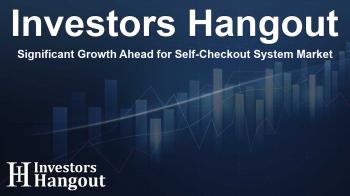Significant Growth Ahead for Self-Checkout System Market

Self-Checkout System Market Expected Growth
The self-checkout system market, valued at USD 5.85 billion, is projected to soar to USD 17.47 billion by 2033. This remarkable growth, anticipated at a compound annual growth rate (CAGR) of 14.68% from 2026 through 2033, is heavily influenced by the increasing demand for retail automation and enhanced customer experiences.
Driving Factors Behind Market Expansion
Today's retail landscape is evolving quickly, with both supermarkets and convenience stores embracing self-checkout systems as a way to enhance operational efficiency and customer satisfaction. The growing need for automated solutions is transforming shopping experiences, reducing wait times significantly while optimizing available retail space.
AI and Consumer Demand
The rise in artificial intelligence (AI) is a game-changer for the retail sector, fostering a trend towards frictionless shopping experiences. Consumers are increasingly seeking technologies that simplify and expedite their shopping journeys. Additionally, there is a strong push from retailers to adopt digital payment methods and automate more processes, which further boosts the self-checkout system market.
Key Players in the Market
Several industry leaders are pivotal in driving this market forward, including NCR Corporation, Diebold Nixdorf, and Toshiba Global Commerce Solutions. These companies are known for their innovative solutions in retail technology, each contributing to the advancement and integration of self-checkout systems.
Growing Adoption of Technology
As retailers focus on cutting operational costs while enhancing customer experience, technology adoption becomes critical. Software and hardware solutions that facilitate seamless checkout experiences are being integrated into various shopping environments. The competitive nature of the market encourages continual improvement and offers numerous choices for consumers.
Segment Analysis
In terms of market segments, fixed systems accounted for 73.20% of market share in 2025, with mobile-based solutions emerging as the fastest-growing segment with a CAGR of 15.40%. This trend illustrates consumers' preference for contactless and mobile-friendly shopping experiences.
Component Breakdown
Looking at components, solutions held the largest share at 70.20% in 2025, driven by the strong uptake of technologies that streamline operations. Meanwhile, the services segment, which encompasses installation, maintenance, and training, is witnessing rapid growth, underlining retailers' need for ongoing support as they adopt new systems.
Sales Channel Trends
The direct sales channel remains dominant with a 58.1% market share, as major retailers are keen on personalized engagements with manufacturers. Interestingly, the indirect sales channel is expected to grow rapidly, fueled by partnerships with third-party distributors adept at meeting the needs of smaller retailers.
End-User Insights
From an end-user perspective, the retail segment continues to dominate with a significant 74.60% market share as of 2025. However, the media and entertainment sectors are emerging with a notable uptick in demand for self-service solutions, indicating a shift in usage trends across various industries.
Regional Analysis
North America currently holds the largest share of the self-checkout system market, supported by significant retailers like Walmart and Kroger. In contrast, the Asia-Pacific region is predicted to be the fastest-growing, propelled by modernization trends and high smartphone penetration rates, which encourage digital payment adoption.
Recent Developments in the Market
Innovation remains a focus as companies such as NCR Corporation and Diebold Nixdorf continue to release updated products and solutions that enhance retail automation. These advancements aim to bolster the efficiency of self-checkout systems further.
Future Prospects in Retail
As the self-checkout system market expands, businesses are encouraged to evaluate their strategies in these changing times. Embracing technology not only promotes efficiency but also enhances the overall shopping experience, setting the stage for enduring growth.
Frequently Asked Questions
What is the projected growth rate of the self-checkout system market?
The self-checkout system market is expected to grow at a CAGR of 14.68% from 2026 to 2033.
Who are the key players in the self-checkout system market?
Major players include NCR Corporation, Diebold Nixdorf, and Toshiba Global Commerce Solutions.
Which segment of the market is growing the fastest?
The mobile-based self-checkout solutions segment is the fastest-growing, with a CAGR of 15.40%.
What are the main drivers of market growth?
Key drivers include increased automation demand, rising use of digital payments, and consumer preferences for seamless shopping experiences.
Which region currently leads in self-checkout system market share?
North America leads with a market share of 32.20%, largely driven by major retailers adopting automation.
About The Author
Contact Dylan Bailey privately here. Or send an email with ATTN: Dylan Bailey as the subject to contact@investorshangout.com.
About Investors Hangout
Investors Hangout is a leading online stock forum for financial discussion and learning, offering a wide range of free tools and resources. It draws in traders of all levels, who exchange market knowledge, investigate trading tactics, and keep an eye on industry developments in real time. Featuring financial articles, stock message boards, quotes, charts, company profiles, and live news updates. Through cooperative learning and a wealth of informational resources, it helps users from novices creating their first portfolios to experts honing their techniques. Join Investors Hangout today: https://investorshangout.com/
The content of this article is based on factual, publicly available information and does not represent legal, financial, or investment advice. Investors Hangout does not offer financial advice, and the author is not a licensed financial advisor. Consult a qualified advisor before making any financial or investment decisions based on this article. This article should not be considered advice to purchase, sell, or hold any securities or other investments. If any of the material provided here is inaccurate, please contact us for corrections.

